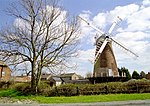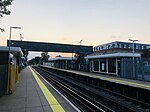Willingdon Down
Sites of Special Scientific Interest in East Sussex

Willingdon Down is a 67.5-hectare (167-acre) biological Site of Special Scientific Interest west of Willingdon, a suburb of Eastbourne in East Sussex. Part of it is a Neolithic causewayed enclosure which is a Scheduled MonumentThis steeply sloping site on the South Downs is species-rich chalk grassland, a nationally uncommon type of habitat. The dominant grasses are sheep's fescue and upright brome and uncommon plants include field fleawort, bee orchid, round headed rampion, green winged orchid and burnt orchid.The site is public open access land.
Excerpt from the Wikipedia article Willingdon Down (License: CC BY-SA 3.0, Authors, Images).Willingdon Down
Butts Lane,
Geographical coordinates (GPS) Address Nearby Places Show on map
Geographical coordinates (GPS)
| Latitude | Longitude |
|---|---|
| N 50.798 ° | E 0.236 ° |
Address
Combe Hill Neolithic Causewayed Enclosure
Butts Lane
BN20 9EN , Ratton Village
England, United Kingdom
Open on Google Maps








